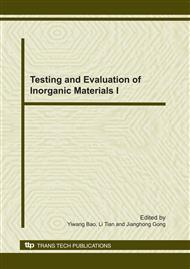p.578
p.584
p.590
p.594
p.598
p.602
p.606
p.610
p.613
Improved Settling Height Method for Characterizing the Stability of Suspension
Abstract:
Traditional settling height method is used to characterize the stability of suspension by the height of sedimentation when suspension is placed undisturbed for some time. However, for the semi-stable suspension with solid loading in the range of 0.1%~30%, it hardly to differentiate the boundary between the liquid and the suspension. In this work, the settling height method is improved that the deflection of average solid loading in the equidistant portions following the settlement direction is used to characterize the stability of suspension. The equipment was improved to achieve the suspension without the disturbance. And the solid loading of each layer is measured by weighing when it was kept undisturbed for some time. Semi quantitative data can be obtained by the improved settling height method that contributes to estimate the stabilization of the suspension, especially the slight unstable suspension. The improved method contributes to decrease the deflection between the data achieved by different researchers.
Info:
Periodical:
Pages:
598-601
Citation:
Online since:
December 2010
Authors:
Keywords:
Price:
Сopyright:
© 2011 Trans Tech Publications Ltd. All Rights Reserved
Share:
Citation:


